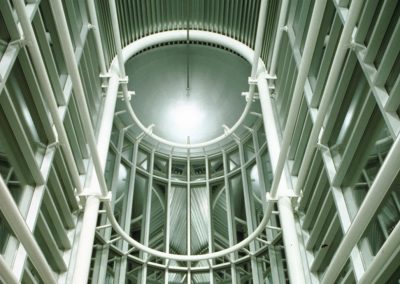Brandon, MB
Situated in the Brandon Escarpment, this highly technical 97,00ft² research facility has a two-storey administration and conference wing with offices for over 25 scientists adjacent to their respective laboratories.
The Research Centre contains a large header house and state-of-the-art computer controlled greenhouses and computer based growth chambers of several sizes. It also has soil conservation, mixing, grinding and drying areas, and laboratories of the following types: large animal, small animal, AID/VID, mean, nutrition, pathology, tissue, isotope, physiology, physical analysis, data processing and genetics.
The Research Centre also features a cafeteria, library, and a 115m long, 3-storey glazed galleria that interconnects all the above functions. This galleria is a gathering space that facilitates the interaction between permanent and visiting researchers, other staff and visitors.
The facility has been specifically designed to accommodate plug-in, plug-out, plug-in capabilities to ensure the simple direct, non-disruptive economical change that is necessary to keep technical facilities at the leading edge.
Structure
Exposed round pipe steel columns connected to wide flange beams.
Skin
The siding is made of an off-the-shelf material called ‘shadow form’, where the metal extrusions interlock and read like weathered barn boards. Laboratory offices are enclosed in standard curtain wall. The custom galleria curtain wall is glazed in green silver mirror glass that reflects the sky, the experimental grain field and the arboretum trees.
Mechanical
Fan coil units are used to heat and cool the labs from water systems. The air systems between the labs, such as the chemical and radiation labs, were designed to ensure that this air couldn’t be mixed. Mechanical rooms are pushed back into the hills.
Action Strategies
The notion of a ‘scientific barn’ generated the attitude of this building. This concept influenced the building’s shape, volume, profile, connection structure and materials. The structure is inspired by the ‘barn’, but reflects the spirit of today’s science and technology.
Key Information
Completed
1995
Project Cost
$17.9M
Building Area
9000 m² / 96,900 ft²
Publications
Canadian Architect – June 1996
Canadian Architect – February 1995
A & E Directions – May 1992
Architecture – Fundamental Issues – 1990
Agriculture Canada Research Centre
Brandon, MB
Situated in the Brandon Escarpment, this highly technical 97,00ft² research facility has a two-storey administration and conference wing with offices for over 25 scientists adjacent to their respective laboratories.
The Research Centre contains a large header house and state-of-the-art computer controlled greenhouses and computer based growth chambers of several sizes. It also has soil conservation, mixing, grinding and drying areas, and laboratories of the following types: large animal, small animal, AID/VID, mean, nutrition, pathology, tissue, isotope, physiology, physical analysis, data processing and genetics.
The Research Centre also features a cafeteria, library, and a 115m long, 3-storey glazed galleria that interconnects all the above functions. This galleria is a gathering space that facilitates the interaction between permanent and visiting researchers, other staff and visitors.
The facility has been specifically designed to accommodate plug-in, plug-out, plug-in capabilities to ensure the simple direct, non-disruptive economical change that is necessary to keep technical facilities at the leading edge.
Structure
Exposed round pipe steel columns connected to wide flange beams.
Skin
The siding is made of an off-the-shelf material called ‘shadow form’, where the metal extrusions interlock and read like weathered barn boards. Laboratory offices are enclosed in standard curtain wall. The custom galleria curtain wall is glazed in green silver mirror glass that reflects the sky, the experimental grain field and the arboretum trees.
Mechanical
Fan coil units are used to heat and cool the labs from water systems. The air systems between the labs, such as the chemical and radiation labs, were designed to ensure that this air couldn’t be mixed. Mechanical rooms are pushed back into the hills.
Action Strategies
The notion of a ‘scientific barn’ generated the attitude of this building. This concept influenced the building’s shape, volume, profile, connection structure and materials. The structure is inspired by the ‘barn’, but reflects the spirit of today’s science and technology.
Key Information
Completed
1995
Project Cost
$17.9M
Building Area
9000 m² / 96,900 ft²
Publications
Canadian Architect – June 1996
Canadian Architect – February 1995
A & E Directions – May 1992
Architecture – Fundamental Issues – 1990









